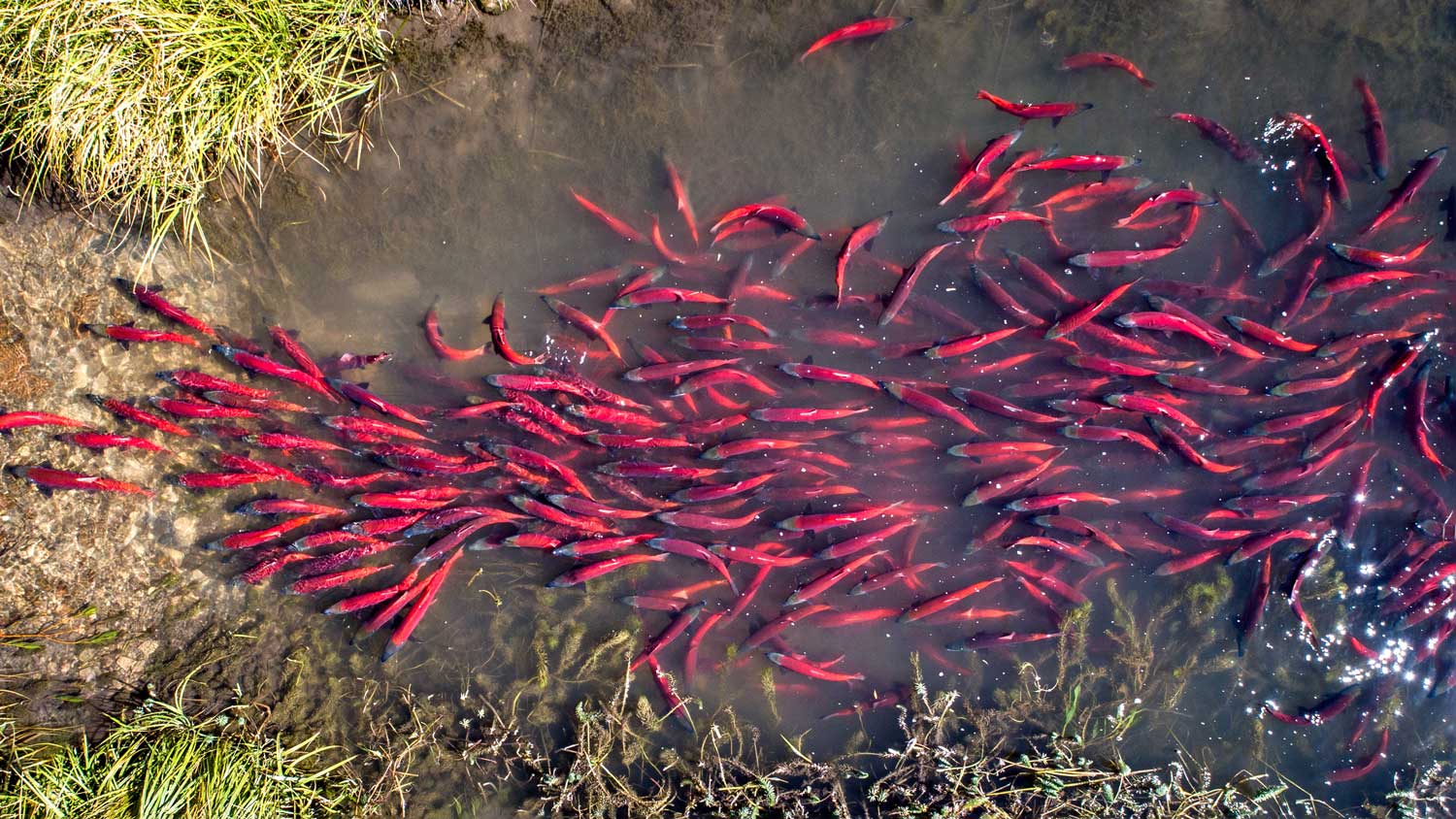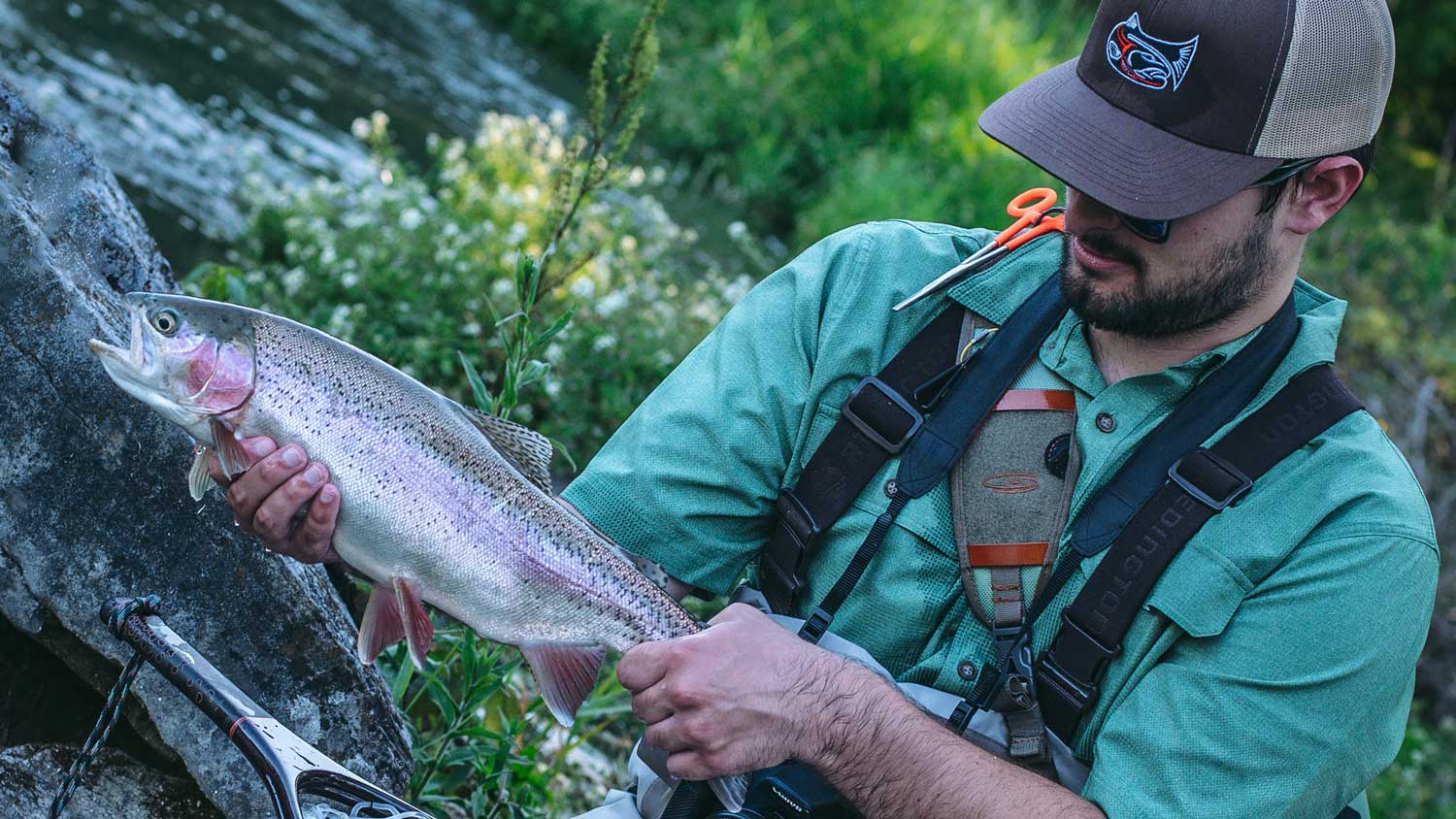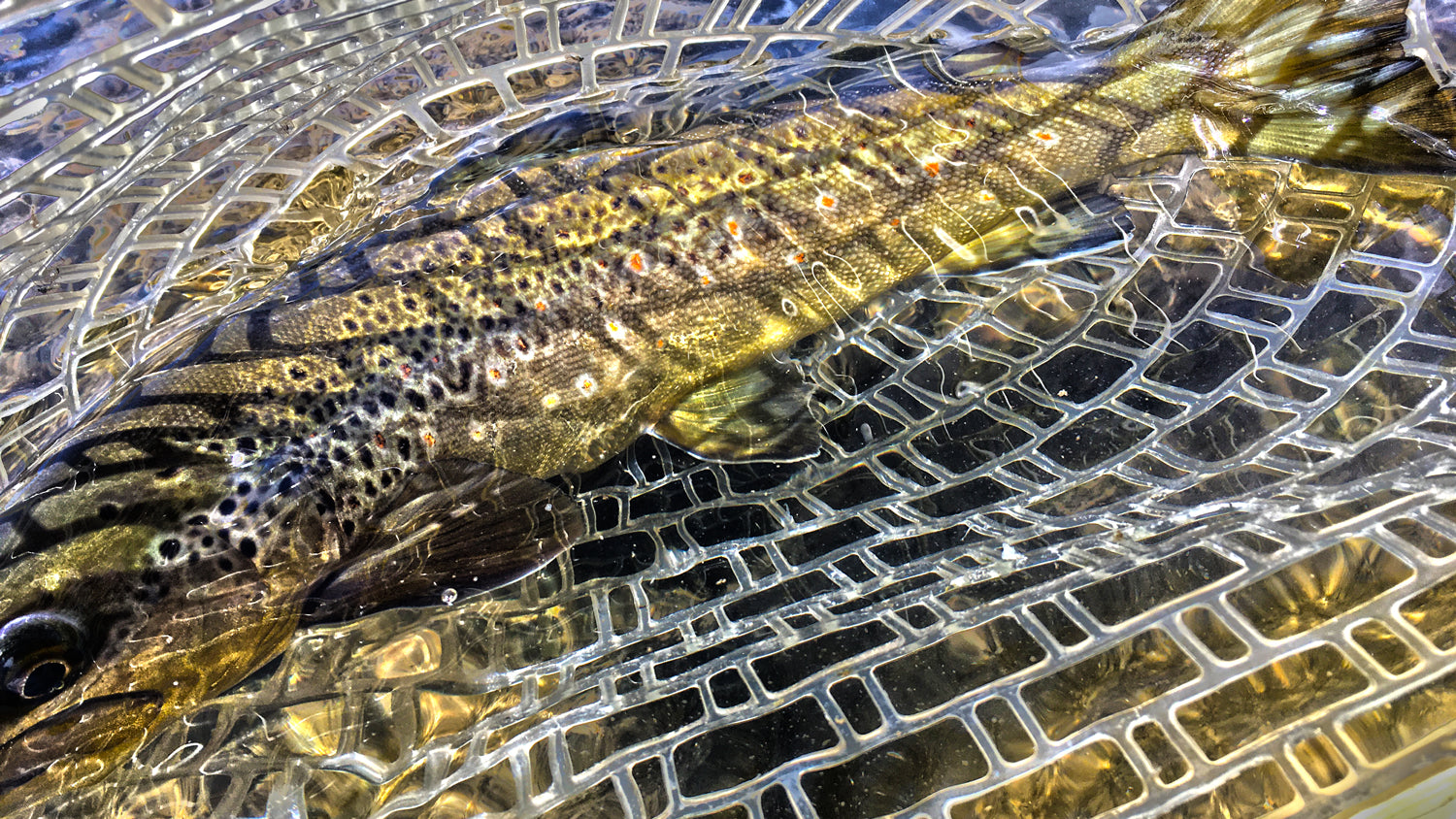The following article will help anyone who wants to learn how to fly fish for Kokanee salmon in the US. If you're a beginner to fly fishing, we will leave no stone unturned, so hopefully, you feel comfortable going out and giving it a go for yourself.

Fly fishing, in general, is renowned for being hard to master. In the US, fly fishing has become immensely popular, mainly due to the vast number of fish species to be caught and its lifestyle. There are so many beautiful lakes and rivers where you can try your hand at fly fishing; all you need is the right knowledge around the subject to go out there and do it for yourself. It's also handy to know about all of the rules and regulations surrounding fly fishing for Kokanee salmon, as in some locations, the species might be protected.
This section aims to answer all of the questions you might have about fly fishing for Kokanee salmon, so keep reading to find out more.
Where Can You Fish For Kokanee Salmon?
The Kokanee salmon is freshwater salmon, meaning you'll never find it in the sea. It can be found in northern US states such as Alaska, Washington, and Utah. There has been some introduction into other states such as New York, Montana, and California to help population growth. Within the states that Kokanee salmon can be found, there are so many beautiful lakes and rivers to fly fish. Let's dive in to see where you can find the Kokanee Salmon.
Grand Lake
The Grand lake is grand, indeed. It's the largest body found in Colorado, and the location it can be found in is also called Grand Lake, it's a name derived from the lake it was built around. Kokanee salmon love it here. If you're looking for a beautifully scenic place to fly fish for Kokanee salmon, it's here. The wide-open space makes you feel genuinely free with your thoughts, and the mountains surrounding you add to the empowering experience you'll have fly fishing for Kokanee salmon.
It's the perfect lake for a beginner to try catching Kokanee salmon due to the water's calm flow and the abundance of Kokanee salmon that can be found there.
It's also a nice perk that the area of Grand Lake is a beautiful place to visit. Shops, bars, and restaurants can be found all around.

Strawberry Reservoir
Found in North-Central Utah, this is the largest reservoir that can be found in the state. It's an extremely popular fishery and is even part of the Blue Ribbon Fisheries program. One of the main species of fish to be found here is the Kokanee salmon, so you can expect a catch no matter how much of a novice you are. The area is not as large as the Grand Lake, meaning those fast swimming Kokanee salmons will be far easier to catch.
There's also a great mixture of other species of fish that can be caught. Again, it's a significant body of water for the novice Kokanee fly fisher because the water is so calm. You'll feel genuinely out in the open here, with the landscape surrounding the reservoir being so vast, which gives incredible scenery.

Tobacco River
This is probably one of the lesser-known spots to go to for Kokanee fly fishing in Montana. There is diversity to be found here in terms of how easy it is to catch Kokanee salmon while fly fishing due to the faster flowing current of the river. It's not the biggest or most glamorous river to try fly fishing for Kokanee salmon, but there is a fair amount of Kokanee salmon that have made the Tobacco river their home.
Although it might be further down on the list of popularity, the river and the local area is so well known for salmon fishing; there's even a salmon fishing festival. If you time your trip right, you could see what it's all about. There's also excellent campsite accommodation found close to the river.

The Salmon River
The Salmon River is located in Idaho and flows for 425 miles, surrounded by a mixture of forest, mountains, open plains; it's a stunning location for fly fishing Kokanee salmon. It has the nickname of 'The river of no return,' due to fishermen traveling down the river but unable to return up many years ago.
It's a river more for those experienced due to the river's fast flow, making it difficult to catch the Kokanee salmon. There is Kokanee fish to be found in abundance here, and variations of salmon and fish.
Many national parks have been created along the river run, which means there are some scenic walks to be done if you fancy it after some Kokanee fly fishing.

What Equipment Will You Need to Fly Fish for Kokanee?
The one thing you might be itching to do so that you can get out and try your hand at fly fishing is buying your equipment. It's always the most exciting part! There are a few essential items and some items that you might like to buy to make fly fishing for Kokanee salmon a little more comfortable for you. But first, here are the essentials:
- A fly rod
- A fly line
- A fly reel
- Fly box
- Flies
Those are that everyone would consider being essentials, now here are some items that you might like to buy to maximize your fly fishing experience:
- Polaroid sunglasses
- A hat
- A net
- Waders and wading boots
There are many more luxuries that you might choose to buy. All you have to do is walk into a fishing shop to get more of an idea of the items you might like to purchase.
When it comes to buying the essential items needed for fly fishing, you might feel like a deer caught in headlights because you don't know what to do, which is why we're going to go into detail about the specific items you need to buy so that you can make an informed decision.
What Fly Rod Should You Use for Kokanee?
Fly fishing for Kokanee salmon will require you to have a trout fishing rod, which differs slightly from regular fishing rods. The rods come in weight sizes ranging from 2 to 12. The rod's weight determines how easy it is to catch certain types of fish. The lower the weight of the rod, the harder it becomes to reel in bigger weighted fish.
For Kokanee salmon fly fishing, you should aim for a rod with a weight of around 4 to 7, depending on the location you wish to fly fishing. It'll be easier to try Kokanee fly fishing with a lower rod weight if you're fishing at a reservoir rather than a river.
If you are trying to cast out long distances for larger Kokanee, you might need up to a size 8 rod.
What Is Rod Action is Best for Kokanee Salmon?
You will have just read how one factor for choosing a rod is the rod action. This, in a nutshell, determines how flexible the rod is. The action is categorized into three subcategories: slow, medium, and fast actioned rods.
The slow action rods have their flexibility at the bottom of the rod, whereas fast actioned rods are flexible at the top, medium action gives flexibility in the middle. For Kokanee salmon fly fishing, it comes down to preference. If you're new to fly fishing, we recommend a medium action fly rod as it will be easier for beginners to cast.

What Fly Reel Should You Choose for Kokanee Salmon?
Some would say that the fly reel is one of the least important pieces of your fly fishing equipment. However, the fly reel will have a significant impact on your ability to reel in big fish.
One of the key points to look for is the weight of your rod. There would be different reels for different rod weights, so for example, if you brought a rod weighted at 5, which is between the 4-7 that we suggested. You would need to make sure you purchase a reel that will accommodate the rod weight of 5. The easiest way to do this is to buy the same size reel as the rod you purchased if you have a 7 weight rod, by a 7 weight reel.
You should also consider the reel drag system, which dramatically affects your ability to reel in fish. If you were to branch out and fish for saltwater fish, a more expensive drag reel system would need to be purchased, however for Kokanee salmon fly fishing, there is no need to splash out on a costly fly reel.

What Fly Line do You Need for Fly Fishing Kokanee Salmon?
Kokanee salmon vary in locations depending on the time of year and the water type you are fishing.
If you're fishing on larger lakes or reservoirs, a weighted line or sink tip line would be preferable and vice versa for fishing in rivers where a standard floating line might suffice.
Take a look at where you plan on chasing down Kokanee before making any buying decisions on your fly line.
What is the Best Time Of Year For Kokanee Salmon Fly Fishing?
It's acceptable to go fly fishing for Kokanee salmon at any point in the year. As long as you're fishing somewhere where the water is not flowing so rapidly, so to make the fish easier to catch, you should always find success fly fishing for Kokanee salmon. It might be more enjoyable for you to go fly fishing during the summer. The weather is warm, the water is calm, but the crowds will be busier.
Generally speaking, to go Kokanee salmon fly fishing, you should be going predominantly between September and October. Those are the two months where salmon runs peak typically. Although it's nicer to fish during the summer, Kokanee salmon prefer cooler waters that can see them dive to the river bed during the warmer months to seek cooler flowing streams. They are also cold-blooded, which means they're less active during the actual winter months of November to February.

Fly Fishing Techniques for Kokanee Salmon in a River
Kokanee Salmon Fly Fishing techniques are very similar to trout fly fishing. But getting your rig set up will help immensely when targeting spawning Kokanee. It would be best if you started with a 9' or 10' tapered leader in 1x or 2x as these fish are formidable fighters during this time. From your leader, run an additional 24" inches of 2x or 3x fluorocarbon tippet using a double surgeons knot.
We will then ty on your first fly using the improved clinch knot. Then run and additional dropper off the hook bend of your first fly using another improved clinch knot. Using a 3x tippet about 10 to 14" behind the first fly, ty on your dropper fly with an improved clinch knot.
Set your indicator approximately 1 and ¾ the length of the section you are fishing. But try and not get the indicator too close to your first fly as it will spook the target you are fishing.
To get your flies deeper in the water column, add an additional split shot (BB) until the desired depth is met. If you are getting hung up on the bottom, remove the split shot.

What Fly Pattern Should I use When Fly Fishing for Kokanee Salmon During Spawning?
During the spawning season, the Kokanee are more concerned about mating then they are about eating. During this time, you are going to want to enact predatory reaction verses and actual feeding presentations. So, in essence, you want to get them mad at you for getting in their way.
The best way to do this is by using fly patterns and are big and flashy. One of the most popular is using egg patterns. Also, large bead headed nymphs, and San Juan Worms are also successful during these times.
Fly Fishing Techniques for Kokanee Salmon in a Lake or Reservoir
Lake fishing differs from river fishing in the lake. You are not targeting the spawning Kokanee in close locations like a river. Here we will be fishing for them depending on the season and water temperature.
During the early spring, when the ice comes off the lake, Kokanee will be looking for optimal water temperatures around 33F to 59F and will be feeding off nymphs such as chironomids (midges) mayfly nymphs.
Kokanee are known to surface feed if the conditions and hatches are optimal. When the warmer months come, Kokanne will go back to the lake's deeper regions, searching larger chironomid hatches.

Keep an eye out for which way the wind is blowing as the water surface's movement will push food to the opposite side of the still water, and you will find them feeding.
Check out our article on leader length here to find out more about setting up your rod for lake fishing with particular patterns.
What Fly Pattern Should I use When Fly Fishing for Kokanee on a Reservoir?
As mentioned earlier, midge and chironomid patterns work successfully during ice off and summer months. Mayfly patterns work as well.
What Are The Rules and Regulations for Fly Fishing Kokanee Salmon?
Depending on where you are fly fishing, there can be strict rules and regulations. Most fly fishing destinations require a license to fish. So make sure you check your location for Some areas is under conservation, which would make it illegal to fish for a kill or fish at all.
Some fisheries also require you to have a fishing license, which is easy enough to obtain. It's also good practice to always put the Kokanee salmon fish back rather than fishing for food.

About the Author
Matthew Bernhardt, a third-generation Coloradan, grew up at the forefront of the state’s fly-fishing revolution, enjoying time on the water, side by side with experienced guides and lifelong anglers.
By combining his passion for fly-fishing with input from other experienced fly-fishers and guides and his fine arts degree from Colorado State University, Matthew spent five years carefully developing the Drifthook Fly Fishing System, built to help every angler catch more trout.
When he’s not spending time with his wonderful family, you’ll find him out on the water catching MONSTER trout, and he anxiously looks forward to the day when his kids are old enough to join him there.







1 comment
Jodie Stovall
Thanks for the great great information. I just moved to Helena Montana and going to use all this wonderful information! hopefully, ‘slay’ will be the success description.
Thanks for the great great information. I just moved to Helena Montana and going to use all this wonderful information! hopefully, ‘slay’ will be the success description.